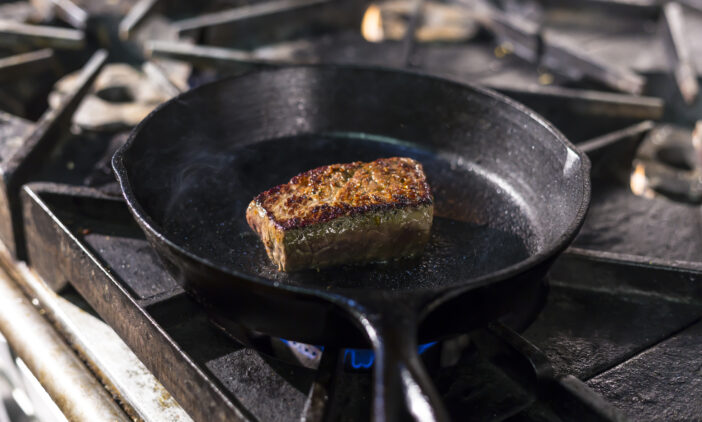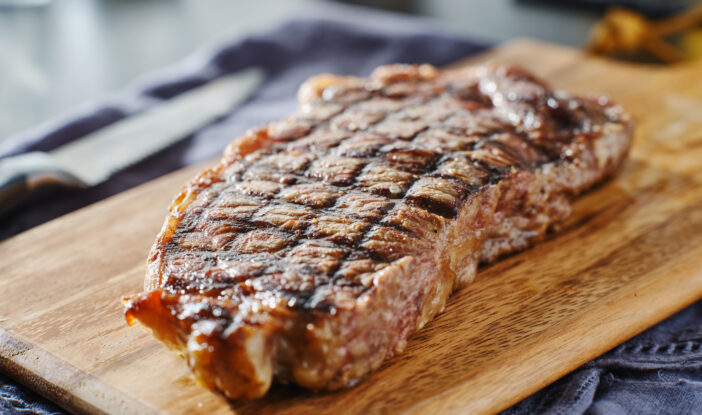5 Steps to Perfect Steak for Juicy, Delicious Results
Master the art of cooking perfect steak with tips on cuts, preparation, cooking methods, temperature control, searing, resting, and pairing for a restaurant-quality experience.

Mastering the art of cooking the perfect steak isn’t just about following a recipe; it’s about understanding the nuances of heat, timing, and seasoning. Whether you’re a grill master or a kitchen novice, these techniques will elevate your steak game to restaurant-quality perfection.
Disclosure: As an Amazon Associate, this site earns from qualifying purchases. Thank you!
Understanding Steak Cuts

Knowing your steak cuts helps you pick the best option for your meal. Different cuts offer distinct textures and flavors.
Choosing the Right Cut
- Ribeye: Rich in marbling, delivering a juicy, flavorful bite. Ideal for grilling.
- Filet Mignon: Lean, tender, and buttery. Perfect for those who prefer a melt-in-the-mouth experience.
- New York Strip: Has a balance of flavor and tenderness. Great for a quick pan-sear.
- T-Bone: Combines both the New York strip and tenderloin. Best for grilling enthusiasts.
- Sirloin: Less fatty, but still flavorful. A more affordable option for everyday cooking.
Factors Affecting Steak Texture and Flavor
- Marbling: Fat distribution within the meat. Higher marbling yields a richer flavor.
- Aging: Dry-aged steaks have a more intense taste. Wet-aged are tender but less flavorful.
- Thickness: Thicker cuts retain moisture and are harder to overcook.
- Cooking Method: Grilling enhances char and smokiness. Pan-searing produces a flavorful crust.
- Grade: USDA Prime, Choice, and Select. Higher grades mean better quality and tenderness.
Preparing Steak for Cooking

Perfectly cooked steak starts with proper preparation. Follow these crucial steps to ensure your steak is ready for the heat.
Importance of Room Temperature
Getting your steak to room temperature is essential. Cold steak can result in uneven cooking, with a raw center and overcooked edges. Leave your steak out for 30-60 minutes to reach the desired temperature, depending on the thickness.
To Season or Not to Season
Seasoning adds flavor and creates a delicious crust. Generously salt your steak for at least 40 minutes before cooking or just before it hits the pan. This allows the salt to penetrate the meat, enhancing its taste. Feel free to add pepper and other spices if desired.
Selecting Cooking Methods

Choosing the right cooking method can change the taste and texture of your steak. Consider these techniques to achieve the perfect steak.
Grilling for Flavorful Crust
Grilling offers intense heat, which creates a caramelized crust while keeping the inside tender. Preheat your grill to high, and cook the steak for 3-4 minutes per side for medium-rare, flipping just once. Use a meat thermometer to check doneness, targeting 130°F.
Pan-Searing for Precision
Pan-searing gives you control over heat and timing, ideal for thicker cuts. Heat a cast-iron skillet over high heat, add oil until it shimmers, then sear the steak for 3-4 minutes per side. Reduce heat to medium and cook to desired doneness, finishing with butter and herbs.
Broiling for Quick Cooking
Broiling uses direct heat from above, perfect for thinner cuts. Position the oven rack 4-6 inches from the broiler, preheat, and broil the steak for 5-7 minutes per side. Keep an eye on the steak to prevent overcooking, aiming for an internal temperature of 130°F for medium-rare.
Mastering the Art of Temperature Control
Nailing the perfect steak requires precision, and it begins with controlling the temperature.
Using a Meat Thermometer
A meat thermometer is your best friend. Insert it into the thickest part of the steak. For rare, aim for 120°F to 130°F. Medium-rare needs 130°F to 135°F, while medium should hit 140°F to 145°F. Avoid overcooking by consistently checking readings.
Understanding Doneness Levels
You need to understand doneness. Rare steaks are cool red in the center. Medium-rare is warm red, medium is warm pink, and medium-well is slightly pink. Well-done steaks have no pink. Knowing these levels ensures you reach your desired doneness every time.
Meat doneness isn’t just about preference; it affects texture and flavor. Choose your target temperature, then use your thermometer for accuracy.
In the video, ButcherBox explains –
Butcher Box
- Texture Changes with Temperature: From raw to well done, the steak’s texture changes significantly, becoming softer as it cooks and then firmer again.
- Rare Steak: Cooked to about 115°F, it feels soft and supple with a bright red center and long, indistinct muscle fibers.
- Medium Rare Steak: Cooked to over 120°F, still soft but springs back quicker, with distinct muscle fibers and a warm red center.
- Medium Steak: Cooked over 130°F, has a hot red center, retaining moisture and appealing to a wider range of tastes.
- Medium Well Steak: Cooked over 140°F, it starts losing moisture and has shorter muscle fibers, with a noticeable color change to pinkish.
- Well Done Steak: Cooked 150°F or higher, it retains some pinkness with less moisture and short, distinct muscle fibers.
- Muscle Fiber Changes: Rare steaks have long, moisture-rich fibers; well-done steaks have shorter, drier fibers.
- Color Indicators: Rare steaks are bright red inside, while well-done steaks show more pink or even grayish hues.
- Importance of Using a Thermometer: A digital thermometer like the Thermapen ensures precise cooking temperatures, eliminating guesswork.
- Personal Preference: Whether rare or well done, knowing when to remove the steak from heat ensures the desired texture and flavor.
The Secret to Perfect Searing

Perfect searing is all about achieving a flavorful crust and enhancing the steak’s texture.
The Role of High Heat
High heat is essential for searing. Preheat your pan until it’s almost smoking. This ensures the Maillard reaction, creating that golden-brown crust. Avoid using medium heat, which leads to uneven cooking.
Choosing the Right Fats and Oils
Opt for oils with high smoke points like avocado or canola oil. Butter adds flavor but burns quickly, so use it towards the end. Use enough oil to coat the pan, ensuring an even sear. Avoid olive oil, which smokes at lower temperatures.
To perfect your searing technique, mastering high heat and selecting the right fats and oils is key.
Resting the Steak: A Crucial Step

Why Resting is Essential
Cutting into a steak right off the heat makes the juices spill out. Resting allows the juices to be redistributed, keeping the steak juicy and flavorful. Scientists say that resting helps carryover cooking, evenly distributing the heat.
Timing the Rest Period for Optimal Juiciness
Resting your steak for 5-10 minutes hits the sweet spot. For thicker cuts, aim for 10 minutes. Use aluminum foil loosely to keep warm without trapping steam. Timing ensures maximum juiciness and the perfect bite every time.
Pairing and Serving Suggestions

Pairing the right sides and wines can elevate your steak experience.
Best Side Dishes for Steak
- Roasted Vegetables: Pair your steak with a medley of roasted carrots, Brussels sprouts, and potatoes. They add flavor and texture.
- Creamed Spinach: Serve a rich, decadent creamed spinach alongside your steak for a classic combination.
- Garlic Mashed Potatoes: Choose creamy garlic mashed potatoes, which complement the savory notes of your steak.
- Grilled Asparagus: Add a fresh element with grilled asparagus—a healthy and delicious side.
- Truffle Fries: Opt for crispy truffle fries to provide a touch of decadence and a satisfying crunch.
Wine Pairings
- Cabernet Sauvignon: Pair with ribeye or T-bone steaks. Its bold flavors match the richness of these cuts.
- Pinot Noir: Serve with filet mignon. Its lighter body won’t overpower the delicate flavor of the filet.
- Merlot: Choose with sirloin steak. The fruitiness and medium body complement the steak’s robust taste.
- Zinfandel: Match with New York strip. Its spicy and fruity notes enhance the steak’s flavor profile.
- Malbec: Pair with flank or skirt steak. Its bold, smoky notes align well with these flavorful cuts.
Frequently Asked Questions
Why is it important to understand different steak cuts?
Understanding different steak cuts helps you select the best option for your desired texture, flavor, and cooking method. Knowledge of cuts ensures you achieve the perfect steak experience every time.
What are the key preparation techniques for cooking steak?
Key preparation techniques include proper seasoning, letting the steak reach room temperature before cooking, and using the right cooking oil. These steps ensure even cooking and enhance the steak’s flavor.
How does temperature control affect steak doneness?
Temperature control is crucial for achieving the desired doneness. Using a meat thermometer helps monitor the internal temperature accurately, ensuring the steak is cooked to your preference without overcooking.
What are some recommended side dishes to pair with steak?
Recommended side dishes include roasted vegetables, creamed spinach, and truffle fries. These sides complement the rich flavors of the steak and create a balanced meal.
Which wines pair well with different steak cuts?
Wines like Cabernet Sauvignon and Malbec pair well with richer cuts like Ribeye and T-bone. For leaner cuts like Filet Mignon, lighter wines such as Pinot Noir are recommended to enhance the flavors.






